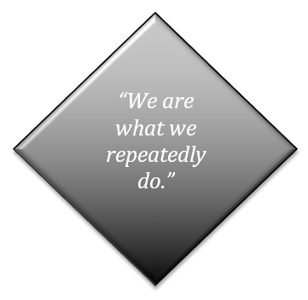At Christmas, my wife, Linda, bought me a cookbook – The Science of Good Cooking. She gave it to me because I really do love to cook. I love to cook because I love to eat. I’m not a foodie who is into exotic or gourmet types of recipes. I’m a basic meat, potato, soup, pasta, BBQ, stew and sandwich kind of guy. You’ll notice the absence of veggies in that list. With the exception of ratatouille, steamed broccoli and sautéed French green beans, I don't do veggies.
Last night was meatloaf night. I hated my mom’s meatloaf. She put ketchup/tomato paste on it! I hated ketchup as a kid and I am still not super fond of it even now. Tomato paste is supposed to be used for just one thing – Dad’s tomato sauce for spaghetti and meatballs! However, a couple of years ago, Linda and the family wanted meatloaf, so I found a recipe from www.allrecipes.com and I’ve been in love with meatloaf ever since.
Originally, what I didn’t know about cooking was the science that makes a dish work or makes a dish a disaster. Over the years, I have learned that…
- Low and slow allows the proteins in meat to breakdown and make most, if not all, “tough cuts” of meat more tender. I followed the practice in smoking meats but not with the Thanksgiving turkey until this last year – WHAT a DIFFERENCE!
- The most important cooking purchase you can make is an instant read thermometer.
- And, for my meatloaf recipe, you can substitute gelatin for veal.

Once you understand the science, what you do next becomes your ART.
The food is your canvas and you get the chance to paint it any way you want. I like food with a little zing, so I tend to add cayenne pepper and/or red pepper chili flakes. In chili or soup, I like to add Tabasco. In my mashed potatoes, I’ve been known to add way too much butter, half and half and jalapeno peppers.
Another example of art and science is exercise and fitness.
If you want to improve your strength or endurance, two things are required - effort and execution. Effort is the science (math) part of the equation. Hypertrophy (growth) of muscle and increases in endurance both rely on the SAID Principle: Specific Adaptation to Imposed Demand. Simply stated: if you want to improve, you must impose a demand on the system. i.e. Lift weights for strength; exercise aerobically to improve cardio-vascular capacity. (This ties into my Nautilus years!)
Failure to impose demands on your physical systems results in atrophy – diminishing capabilities of the muscles to work or the lungs to supply oxygen.
The “art” of exercise is when you decide what you want to do to impose the demand.
- Lift weights
- Pilates
- Swim
- Bike or run long distance
- Martial Arts
- Cross country skiing
As long as you stress your systems, you will become more fit. You muscles or lungs cannot distinguish one kind of load (training) from another. All the systems know is that they are being taxed and so they respond with growth/improvement.
What Makes Up the Science of Sales Growth – Activities that Lead to Results
What is the science of sales growth then? The science is the activity that leads to results. This can be a long list, but it all comes down to this:
EFFORT
- Networking face-to-face in the community of your target market
- Making phone calls to the people whose names you have come into possession of (regardless of source)
- Active social selling using LinkedIn
- Meeting with internal partners who have access to people in your target market
- Providing an exceptional client experience so your clients become advocates and introduce you to others
- Directly asking clients for introductions
- Spending time with and being a great partner with other business partners so that they can refer business to you
- Writing articles, speaking and presenting to become the subject matter expert in your target market so that people seek you out.
EXECUTION – THE ART (HBR Video)
- How well do you ask questions?
- When you are making a point, do you weave in metaphors, analogies and stories or do you simply quote data and statistics?
- How high is your emotional IQ?
- Are your questions the type of questions that provide meaningful insight to the emotions of action or ones that uncover “just the facts”?
- How memorable or forgettable are you when you call to talk to someone on the phone for the first time?
- How well do you “own the room” when you present?
- When you present, do you look, act and sound like everyone else?
- Are you emotional, passionate and willing to do whatever it takes (assuming ethical, legal and moral standards)?
ARE YOU GROWING? (Growing Sales Article Part I)
- What demands have you put on your behaviors to stretch your thinking and your abilities?
- What training or coaching have you undertaken that makes you uncomfortable, stretches your thinking and broadens your scope of conversation?
- How comfortable are you with having presidential, far reaching and/or vision creating discussions with decision makers who are resistant to change?
- In the last 18 months, how many books have you read, workshops or webinars attended, or speakers have you listened to on TED Talks or YouTube?
- Are you twice as smart about your business and the art and science of selling than you were 18 months ago?
- How indispensible are you to your company and clients?
- What do your numbers reflect:
- Personal income
- Sales goal increases year over year
- Your sales goal achievement compared to the best in class
- Your personal wealth
- The things you have, achieve, go, become
- How secure is your future financial wellbeing?
- If something happened to you today and you could no longer work, how well would your family be cared for financially?
- Would your company enthusiastically hire you again?
As a manager of salespeople, these are the questions you need to be asking. These are the points that you need to be thinking about/considering when discussing the building of a sales growth oriented sales team.
How Sales Leadership Establishes “The Science”
The Science: My guess is that, in your organization, you have a CRM that provides you some math to help you with the science part. CRMs are sales enablement tools. They are only designed to collect the data; sales leadership has to do the rest. The rest – is the science:
- Identify the right metrics – data to collect
- Have standards applied to those metrics that force your people to grow
- Connect the metrics in a milestone structured sales process
- Create success formulas for all producers
- Compare actual performance to goal performance (including conversion ratios)
- Obtain business intelligence that is predictive of future performance
- Compare predictions to actual
The Art Needed for Growing Your Sales Team
The Art: The art of growing your sales team combines the data that you have with your coaching opportunities. There are skills required to be an effective coach. Your ability to artfully execute these skills is what makes it easier to recruit top talent and keep the talent you have.
- Having deep relationships based on confidence and trust
- Understanding what really motivates your people
- Asking great questions that help your salespeople discover what they should be doing
- Not accepting mediocrity
- No need for approval without being aggressive
- A coaching bias – it’s more important to see your people succeed than for you to succeed
Additional Resources:
Download our Why is Selling So #%&@ Hard ebook
Watch our Sales Guy Unplugged Videos
Read more about Setting Standards





